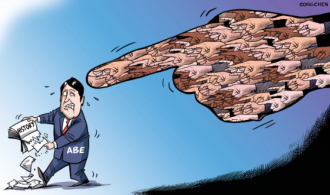China doom-sayings are based on separating facts and rhetoric
By Danny Quah (chinadaily.com.cn) Updated: 2016-02-19 13:20"Well, maybe no …"
Is this analysis correct? Sure, no large mature economy grows faster than 3 percent a year for any significant duration. So too will China at some point.
But is that time now?
Perhaps not. First, consider the significance to the real economy of China's slowing growth rate. Recall that in 2005 China's GDP amounted to US$2.3tn. At a 12 percent growth rate then, China generated an increase in real economic value of US$274bn. In 2015, however, China's GDP came to US$11.3tn. A 7 percent growth in this economy increases value by US$790bn, i.e., almost three times that a decade ago during China's halcyon days of economic growth. Seven percent is no meltdown. And if productivity were to grow as in 2013, 7 percent growth in today's China will generate 53 million new jobs.
At the end of 2015, China's nonmanufacturing PMI stood at 54.4, a 16-month high. Perhaps the low manufacturing PMI correctly signals a dramatic slowdown. Or it might simply show China navigating its structural transition.
Next, take China's currency. Against the US dollar the RMB has indeed slid 6 percent since August 2015. But measured against a basket of trade-weighted currencies, China's currency never dipped below its January 2015 level all last year. Between 2006 and 2015, China's currency appreciated 20 percent against the US dollar and 22 percent against the Euro. The BIS reckons China's currency has since 2010 soared 30 percent against its major trading partners. Factoring in inflation, the RMB real exchange rate strengthened more than 50 percent in the last decade. This is no currency in distress.
But numbers form only part of the story here. The world flip-flops constantly in what it expects of China's exchange rate policy. On the one hand, observers worry how China spent half a trillion dollars of reserves supporting the RMB. On the other hand, if China hadn't done so but instead permitted the RMB to fall, outcries of competitive devaluation would have deafened.
Last August China followed IMF advice and allowed each morning's exchange rate fix to hew to the previous evening's close, i.e., to be more market-oriented. That first day resulted in a small decline of the RMB. Global markets promptly panicked and charged China with depreciating its currency to bolster manufacturing exports. It's damned if you do and damned if you don't.
Finally, take China's stock markets. Equity markets, in theory, reflect the best forecast of the future profits stream in business enterprises. This results from the agglomerated action of many, many investors trading on new information they are expertly interpreting. So, in theory, when equities decline, bad times beckon.
But China's stock markets? These are thin, with most of the relatively few participants only retail investors. One writer, following last summer's stock market gyrations, observed, "China's market is detached from fundamentals. It neither contributed much to economic growth while it was rising, nor threatened the economy when it collapsed." (Indeed, even for advanced economies, Paul Samuelson famously quipped in 1962 that Wall Street was so good at prediction, it had been able to forecast nine out the last five US recessions.)
China's government has learnt from advanced economies that business should raise more financing from equity markets, and that those markets can offer attractive options to consumers otherwise bereft of high-yielding savings opportunities. But China's financial markets remain woefully under-developed. Do their vagaries reflect this lack of maturity—observed across most of Asia's developing economies—or inept policy-making? Likely both, but not exclusively the latter.
What about China's circuit-breaker system? Its function is to give pause to excessive movement in markets driven by panic selling or faddish enthusiasm. That seems sensible but any such system carries at least two design faults. First, it prevents immediate recovery, and second, it incentivizes panic selling once the market visibly heads down. Were China's circuit breakers fundamentally ill-judged?
China's system did not appear out of nowhere. Following China's stock market gyrations last summer, a system was proposed in September, after which policy-makers sought and accepted input from market participants for its final design. A similar system had been put in place in the US after Oct 1987. As no circuit-breaker can come without those two design faults, it cannot be the logic of the design that accounts for the difference between a successful US system and a failed Chinese one. Instead the explanation must lie only in the parameters chosen. The US system has thresholds that, relative to US stock markets, would have kicked in only three times since the 1930s. China's circuit-breaker parameters? Given China's markets, its circuit-breakers, had they then been in place, would have tripped 20 times between June and August last year.
China's circuit-breaker errors were not anything deep in logic or politics, merely in numerical parameters.
Conclusion
Recent events in China's economic trajectory have set off alarm bells for many observers. But these same incidents, set against a slightly more textured background, are actually nuanced in their implications.
China is not imminently in meltdown.
None of this is to say China's economy will continue growing at double digit rates forever. Nor does it argue China's policy-makers have consistently done the right things. But neither are those policy-makers obviously guilty of incompetence or excessive interventionism.
Steep challenges lie ahead. China's pile of debt is a tricky mix of privatized, local governmental and national obligations, and there remains considerable uncertainty how this debt hangover will work out. China's industrial restructuring, its anti-corruption campaign, its transition past the Lewis Turning Point and out of the middle-income trap, and its environmental and demographic challenges all remain daunting. These challenges are substantive and long term, and China's policy-makers will have to deal with them in a properly measured and considered way.
But China's exchange rate and stock market gyrations? They have likely already attracted far too much attention relative to substance.
Danny Quah is Director of the Saw Swee Hock Southeast Asia Centre at the London School of Economics and Political Science(LSE) and he is also a professor of Economics and International Development at LSE.
This article was originally published on Asia House on January 19, 2016. Some editings have been made under the authorization of the author.
The opinions expressed here are those of the writer and don't represent views of China Daily website.











